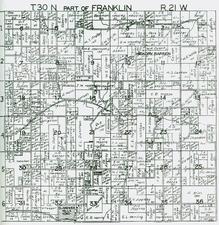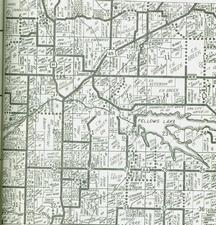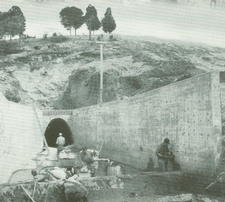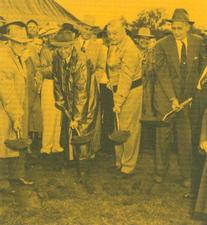Fellows Lake
 Years of planning a monumental step. [a booklet issued by Springfield City Water company ca. 1955]
Years of planning a monumental step. [a booklet issued by Springfield City Water company ca. 1955]
"Since 1920, with the employment of nationally-known consulting engineers, the Springfield City Water Company has undertaken comprehensive studies for the expansion of its water sources. One result of these studies was the construction of McDaniel Lake in 1928 to supplement existing water supplies. Engineers estimated McDaniel Lake would be adequate until 1960, under normal growth.
"With Springfield growing rapidly in the post-war period, the company in 1947 engaged engineering firms to survey carefully all areas surrounding Springfield and to make recommendations on the most practical development for the company to undertake next. Continuous surveys were made during the years 1947 to 1953 with this end in view. Comprehensive studies were made of the James River, deep well supplies, impounding dams on the Sac and other rivers.
"The early reports in 1948 and 1949 by Alvord, Burdick and Howson, engineers of Chicago, recommended the utilization of dams on the North Sac River and an alternate proposal which was too costly to merit consideration. In 1953, the firm of Malcolm Pirnie Engineers of New York City was employed by the Springfield City Water Company to make an independent survey and recommendations. The report was completed and presented to the Board of Directors of the company on January 25, 1954. The Pirnie Report expanded the recommendations in the reports of Alvord, Burdick and Howson by the use of one large dam on the North Sac River and later, perhaps in 25 to 30 years, a large impounding dam on the headwaters of the James River.
"On the day it was presented, directors unanimously approved the Pirnie Report, in which the Howson firm concurred. Officers of the company were authorized to order detailed plans and specifications for the Sac River dam and lake. Preliminary work began immediately. Test borings were made to determine the best location for the dam. The entire area was analyzed. The purchase of land began. On March 22, 1954, the company went before the Missouri Public Service Commission and formally asked for a certificate of convenience and necessity to build the dam. It was granted.
"During the Spring and Summer of 1954, bids were received from nine contractors for construction of the damA base bid of $1,652,000 from M. E. Gillioz of Monett, Missouri, was accepted. Completion was promised by October 30, 1955. On October 30, 1954, ground formally was broken for the dam. That same day, equipment of the Gillioz Company moved onto the dam site and began carving out a monumental step forward for the Springfield City Water Company.
Facts and Figures
"The dam of Fellows Lake is on the Sac River, approximately five miles upstream from McDaniel Lake. It will make use of about half of the 40-square-mile watershed that had served McDaniel Lake.
"Figures of engineers show that the watershed is adequate to support both lakes. Since it was put into service it is estimated that six time as much water as has been taken from McDaniel Lake has been wasted over its spillway. Fellows Lake is designed to prevent such waste.
"The dam forming Fellows Lake stretches 2,700 feet, including a 700-foot spillway, across the Sac River valley.
"From a width of 605 feet at its base, the dam tapers to 20 feet at the top, 102 feet above the valley. To form the dam, it was necessary to move 1,477,700 cubic yards of earth.
"Through the center of the dam runs a core of selected clay, compacted to give an impervious zone to prevent passage of water or seepage through the dam. The core tapers from 100 feet in width at the base to 15 feet wide at the top.
"From the overflow of the spillway, a 1,400-foot paved section will carry the water at times of overflow back into the original stream bed, to flow by gravity into McDaniel Lake. However, water may be taken from Fellows Lake long before it overflows. A diversion tunnel, 808 feet long, was cut through the hill at the south end of the dam. Through a concrete intake tower, which is 97 feet tall, water may be taken at for different levels and sent through the tunnel and into the stream bed to flow into McDaniel Lake.
"When Filled, Fellows Lake will inundate approximately 820 acres and will contain 9,070,000,000 gallons of water.
"It required approximately 20,000 man hours of labor to construct the dam and its appurtenances. Total cost, including land, is about $2,950,000.
"The lake was named for Homer F. Fellows (1832-1894) and his son Homer F. Fellows.
"Ground for Fellows Lake Dam was broken at ceremonies on October 30, 1954. Wielding the shovels are Jasper W. Everett, Vice president and General manager of the company; John K. Hulston, president of the Chamber of Commerce; H. Frank Fellows, after whose family the lake was named, and Mayor W. L. English."
Below are two land ownership maps that show the lake area before and after the building of Fellows Lake. The first one is from 1927 and the second is from 1974. Click on the image to enlarge it.
 |
 |
Find this article at http://thelibrary.org/blogs/article.cfm?aid=943&view=print

